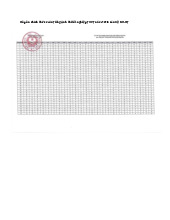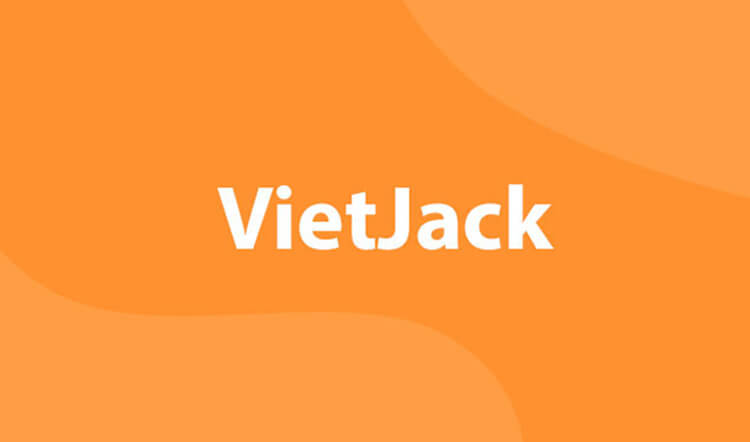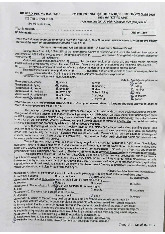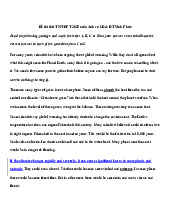














Preview text:
Đề thi thử tốt nghiệp THPT 2025 môn tiếng Anh sở GD&ĐT Hải Phòng
Read the following passage about the consequences of impulse buying and mark the letter A, B,
C, or D on your answer sheet to indicate the best answer to each of the following questions from 1 to 10.
Online shopping has exploded in popularity, with e-commerce sales reaching nearly $5 trillion
worldwide in 2021. This growth is largely due to the convenience and variety that online
platforms offer. Shoppers can browse millions of items from home, and with services like
Amazon Prime, products can arrive in just one or two days. However, while online shopping
offers numerous advantages, it has also led to increased impulse buying behaviours among consumers.
[I] Impulse buying, or buying things without planning or need, is more common online than in
physical stores. [II] A study by Klarna found that 71% of online shoppers admitted to making
impulse purchases. [III] For example, on popular shopping days like Amazon Prime Day, people
may feel pressured to buy items they haven't considered before, simply because they're marked as
“exclusive” or “limited-time offers.” [IV] Such deals create a sense of urgency, making
consumers feel they might miss out if they don't act fast, which can lead to spending regret later.
This impulse buying can have serious financial consequences, especially among younger
people. According to a survey by Finder, Americans spend around $183 per month on impulse
purchases, which adds up to over $2,000 each year. For younger consumers, especially teenagers
and young adults, the effects can be more significant. Many use credit cards or “buy now, pay
later” services, such as Afterpay or Klarna, which can make spending feel easier but may lead to
debt. A 2022 survey revealed that 43% of millennials and Gen Z consumers reported regret
over impulse purchases made with "buy now, pay later" options, as they faced challenges with repayments.
Experts suggest several ways to avoid impulsive spending, like setting a budget, removing
items from the cart and waiting a day before buying, and unsubscribing from marketing emails.
By taking a moment to think before clicking “buy now,” consumers can make more informed
decisions and avoid accumulating items they don’t need or facing financial issues. Online
shopping has revolutionised the way we buy, but it's essential for people to shop responsibly to
avoid the pitfalls of impulse purchases.
(Adapted from Guide to the National Examination)
Question 1: The word itin paragraph 1 refers to______. A. impulse buying B. convenience C. online shopping D. Amazon Prime
Question 2: Where in paragraph 2 does the following sentence best fit?
This is often encouraged by tactics such as “limited-time deals” and “only 3 left in stock” notifications. A. [III] B. [IV] C. [I] D. [II]
Question 3: The phrase spending regret in paragraph 2 could be best replaced by______. A. financial hardship
B. purchase disappointment C. buyer satisfaction D. money management
Question 4: Which of the following best paraphrases the underlined sentence in paragraph 3?
A. Millennials and Gen Z thoroughly enjoyed using “buy now, pay later” services because they
can make purchases without any trouble.
B. Nearly half of young consumers regretted purchases made through “buy now, pay later”
services due to difficulties with repayments.
C. The majority of young consumers were reported to experience no problems with
repayments for “buy now, pay later” purchases.
D. Younger people did not show any regrets about impulse purchases that they made using the
services called “buy now, pay later”.
Question 5: Which of the following best summarises paragraph 3?
A. Younger consumers are most affected by financial problems due to impulse buying.
B. Online shopping is generally not impulsive for adolescents as well as young adults.
C. Financial challenges from online shopping are likely to affect older adults the most.
D. Most impulse purchasers tend to use cash to manage their spending and avoid debt.
Question 6: According to paragraph 4, which of the following is NOT a suggested method to avoid impulsive spending?
A. Removing items from the cart and waiting a day before buying
B. Unsubscribing from marketing emails
C. Setting a budget before shopping
D. Subscribing to promotional emails for discounts
Question 7: The word accumulatingin paragraph 4 is OPPOSITE in meaning to ______. A. increasing B. gathering C. reducing D. purchasing
Question 8: Which of the following is TRUE according to the passage?
A. Experts recommend that online shoppers should buy items immediately in order to avoid impulsive spending.
B. Young people who use “buy now, pay later” services often have no difficulty in managing their finances.
C. The average American is reported to spend less than one thousand dollars annually on impulse purchases.
D. Millennials and Gen Z report more regret over impulse purchases when using “buy now, pay later” services.
Question 9: Which of the following can be inferred from the passage?
A. Consumers have a tendency to remain unaffected by time-sensitive offers when making online purchases.
B. Techniques that create urgency encourage impulse purchases, especially among younger demographics.
C. The popularity of online shopping rarely contributes to a sense of post-purchase regret among consumers.
D. “Buy now, pay later” options are known to encourage fiscal responsibility and reduce impulsive spending.
Question 10: Which of the following best summarises the passage?
A. Online shopping is preferred primarily because of its affordability, with almost all
consumers making every effort to avoid impulse buying and make only well-planned purchases in advance.
B. Despite the risk of financial issues, limited-time offers in online shopping are specifically
designed to ensure that consumers make quick purchasing decisions to minimize the potential for regrets.
C. Impulse buying is generally considered to be a minor concern and primarily limited to
major shopping events, which briefly increase the tendency to make spontaneous purchases online.
D. While online shopping offers significant convenience, it also fosters impulsive purchasing
behaviours that can lead to both financial regret and challenges, particularly among younger consumers.
Read the following leaflet and mark the letter A, B, C, or D on your answer sheet to indicate
the correct option that best fits each of the numbered blanks from 11 to 16.
PROTECT OUR PLANET - YOUR ACTIONS MATTER
Why care about the environment?
The environment is our life support system, providing us with clean air, water, food, and
countless (11) ______ resources. However, human activities are threatening the health of our
planet. Understanding and (12) ______ these issues is crucial for our survival and the well-being of future generations.
How you can make a difference
֍ Reduce, Reuse, Recycle: (13) ______ waste by choosing reusable products, recycling
materials, and composting organic waste.
֍ Conserve Energy: Use energy-efficient appliances, switch to renewable energy sources, and
reduce unnecessary energy consumption.
֍ Water Conservation: Fix leaks, install water-saving fixtures, and practice (14) ______ to protect this vital resource.
֍ Sustainable Transportation: Walk, bike, carpool, or use public transport to reduce your carbon footprint.
֍ Support Eco-friendly Products: Choose products (15) ______ from sustainable materials
and support companies with environmentally responsible practices.
֍ Protect Wildlife: Support conservation (16) ______, reduce habitat destruction, and avoid
products that harm endangered species.
(Adapted from https://www.ukh.edu.krd) Question 11: A. another B. other C. the others D. others
Question 12: A. concerning B. relating C. addressing D. dealing Question 13: A. Put out B. Cut down C. Break off D. Take up
Question 14: A. use mindful water
B. mindful use water C. water mindful use D. mindful water use
Question 15: A. which made B. making C. made D. was made Question 16: A. systems B. efforts C. matters D. sources
Read the following passage about earthquakes and mark the letter A, B, C, or D on your
answer sheet to indicate the best answer to each of the following questions from 17 to 24.
Earthquakes occur as a result of sudden shifts in the Earth’s tectonic plates. Sometimes they
are characterized by a sudden violent shaking of the ground. Depending on the amount of energy
released in an earthquake, the geographic location of an earthquake’s initial ground rupture, and
the population density in the area surrounding this ground rupture, earthquakes can have severe consequences to human life.
Scientists use the Richter scale to measure the force or power of an earthquake. Developed by
Charles F. Richter in 1935 in conjunction with the California Institute of Technology, the scale
is used to record earthquakes from less than 2.0, microearthquakes, all the way up to more than
10.0 known as “rocky meteorite impacting,” the likes of which have never been recorded.
Microearthquakes measuring 2.0 or less on the Richter scale occur at a rate of about 8,000 per
day. These are never felt and are considered harmless. Minor earthquakes lay between 3.0 – 3.9
on the Richter scale. They are often felt, but seldom result in any damage. It is estimated that
there are around 49,000 minor earthquakes per year. Measuring in at 6.0 – 6.9 on the Richter
scale, a strong earthquake can devastate areas within a 100-mile radius of the initial ground
rupture point, as witnessed in several earthquake-prone zones throughout the world. Strong
earthquakes occur at a frequency of about 120 per year. A great earthquake can be extremely
destructive in areas several hundred miles across. Great earthquakes measure in at 8.0 – 8.9 on
the Richter scale. Earth averages one great earthquake per year.
Scientists have estimated that the 1906 San Francisco earthquake could have measured
between 8.0 and 8.9 on the Richter scale. This earthquake ruptured 296 miles off the San Andreas
Fault. Important scientific research of the great San Francisco earthquake spawned new theories
about the source of earthquakes. For example, the elastic-rebound theory was developed by Reid
in 1910 after he had carefully researched the displacement and strains in the crust surrounding the
rupture. It is still the basis for studying the earthquake cycle.
(Adapted from Toefl iBT Reading)
Question 17: Which of the following is NOT mentioned in the passage as a characteristic of earthquakes?
A. Some earthquakes are never felt.
B. They are measured by the Richter scale.
C. They can cause devastation.
D. They can topple large buildings.
Question 18: The word severe in paragraph 1 is OPPOSITE in meaning to ______. A. direct B. profound C. minor D. serious
Question 19: The phrase in conjunction with in paragraph 2 could be best replaced by______. A. together with B. apart from C. instead of D. other than
Question 20: Which of the following best paraphrases the underlined sentence in paragraph 3?
A. Only earthquakes that are several hundred miles away are considered severely damaging.
B. Earthquakes that are extremely severe occur hundreds of miles from where they strike.
C. A big earthquake can cause serious damage in areas stretching for several hundred miles.
D. A strong earthquake can cause widespread destruction over areas hundreds of miles away.
Question 21: The word It in paragraph 4 refers to ______. A. crust B. rupture C. displacement
D. the elastic-rebound theory
Question 22: Which of the following can be inferred from the passage about the 1906 San Francisco earthquake?
A. It was not very destructive even though it measured over 8.0 on the Richter scale.
B. It is considered to be the worst natural disaster that has ever happened in history.
C. It caused mass devastation and became one of the most famous earthquakes in history.
D. After its occurrence, the scientific community learned very little about earthquakes.
Question 23: In which paragraph does the writer point out the causes of earthquakes? A. Paragraph 3 B. Paragraph 4 C. Paragraph 2 D. Paragraph 1
Question 24: In which paragraph does the writer mention the development of new theories about earthquakes? A. Paragraph 4 B. Paragraph 2 C. Paragraph 3 D. Paragraph 1
Read the following passage about the harmful impact of keeping elephants in zoos and mark
the letter A, B, C, or D on your answer sheet to indicate the option that best fits each of the
numbered blanks from 25 to 29.
One of the main arguments in favour of large animals living in zoos has been called into
question, at least in the case of the particularly large ones. Wildlife experts are warning against
having elephants in zoos for they have far shorter lifespans there than they do in the wild or as working animals.
The source of this is a survey blaming the captivity of elephants for the fact that they (18)
______. Asian elephants used as working animals live for an average of 41.7 years, while Asian
elephants in zoos only reach the age of 18.9 years on average. African elephants in zoos live for
16.9 years on average, far less than that of African elephants in the wild at 35.9 years. (19) ______.
The question which needs to be asked is why. (20) ______. African elephants in the wild
cross huge areas of grassy land every year; Asian elephants are used to work in transportation and
agriculture. It is not uncommon for an elephant in a zoo to be restricted to an area the size of a
football pitch. This restrictive habitation, (21) ______, leads to stress.
The report, the work of wildlife scientific officer Ros Clubb, proves one widely held belief
completely wrong – namely, the idea of life in a zoo being longer, healthier and happier than life
in the animal’s natural habitat. Wildlife experts are recommending every zoo should rethink the
captivity of elephants (22) ______.
(Adapted from Use of English for Advanced) Question 25:
A. live half as long in zoos as those living free or working
B. whose lifespan is not so long as that of the wild and free
C. which have a longer life than those in the natural world
D. having been in zoos as long as those in the wilderness Question 26:
A. Additionally, elephants born in zoos have a comparatively low chance of surviving to adulthood
B. Yet, elephants will have better chance of reaching full maturity provided that they are born in zoos
C. Therefore, elephants raised in captivity have higher chance of survival compared to grown ones
D. In contrast, it is rather unlikely for adult elephants to stay alive in captivity as baby elephants do Question 27:
A. The report is entirely to take the blame for the lack of exercise and stress factors
B. The report says that two factors are largely to blame: lack of exercise and stress
C. Such two factors as stress and lack of exercise are reported to deny responsibility
D. Two factors, namely stress and lack of exercise, are held responsible for the report Question 28:
A. accompanied by the occasional arrival of calm, silent, camera-free staff members
B. combined with the constant stream of curious, chatty, camera-wielding visitors
C. comes together with the continuous flow of eager, talkative, photo-taking tourists
D. integrating into the irregular appearance of indifferent, quiet, device-freeguests Question 29:
A. and possibly stop keeping all large animals in zoos altogether
B. but ensures better living conditions for all larger animals
C. or putting a stop to all large animals being kept in captivity
D. while making attempts to capture all animals in larger zoos
Mark the letter A, B, C, or D on your answer sheet to indicate the best arrangement of
utterances or sentences to make a meaningful exchange or text in each of the following
questions from 30 to 34. Question 30:
a.The burning of wood for heating purposes is likely to produce little in the way of carbon
emissions and is therefore considered to be friendly to the environment.
b.Wood and coal are both useful sources of energy, and both are constantly in use around the world.
c. Coal, on the other hand, is termed the “enemy of the environment” as it is the largest source of
carbon emissions and is the greatest contributor to global warming.
d. This is because wood burning produces only as much carbon as if the tree were left alone to eventually rot in the ground.
e.However, while they each have their merits as fuel, the problems and hazards associated with their use are very different.
(Adapted from Toefl Reading) A. b-e-a-d-c B. e-a-b-d-c C. d-b-e-a-c D. a-d-b-e-c Question 31:
a. It is also true for young and middle-aged adults, as improved physical function helps them
more easily accomplish the tasks of daily living.
b. This is true for older adults, for whom improved physical function reduces risk of falls and
contributes to their ability to maintain independence.
c. Apart from improving physical function, physical activity may improve cognitive function among youth and adults.
d. Aspects of cognitive function that may be improved include memory, attention, executive
function, and academic performance among youth.
e. Physical activity improves physical function among individuals of all ages, enabling them to
conduct their daily lives with energy.
(Adapted from https://www.odphp.health.gov) A. e-d-a-c-b B. e-b-a-c-d C. e-c-a-b-d D. e-a-b-d-c Question 32: Hi Henry,
a.In addition to this programme, we have monthly tree planting, with the next one taking place this Sunday at 8 am.
b.You don’t need to tell us in advance that you’re going to participate - just turn up in person and join in.
c.We’ve also got programmes for community gardening, in which we plant a few crops in local
plots, usually done in spring or autumn.
d.In answer to your question about voluntary work, there are several programmes that are currently operating.
e.One that may interest you is our weekly neighbourhood clean-up, which in general involves
picking up litter in the streets. I look forward to seeing you! Best regards, Jill Thomas
(Adapted from Use of English for First) A. e-c-a-d-b B. c-d-e-a-b C. d-e-a-c-b D. b-a-c-e-d Question 33:
a.Peter: Well, I’ve got two tickets for the Blue Stars concert.
b.Mary: Hi, Peter. Saturday evening? I’m not sure yet. Why?
c.Peter: Hi, Mary. Are you free on Saturday evening? (Adapted from KET) A. a-b-c B. c-a-b C. c-b-a D. a-c-b Question 34:
a.Joe: But you did, after all. Honestly, I’m thinking about taking the bus to work.
b.Mia: That’s for sure. It’s so much worse here than in the countryside. Sometimes I wish I hadn’t moved.
c.Joe: You know, more and more people are moving to the city, and traffic just keeps getting worse.
d.Mia: Seriously? It’ll take you longer, and you’ll have to get up very early.
e.Joe: It’s true, but at least I won’t be stuck in traffic for hours or spend extra on petrol.
(Adapted from Global Success) A. c-b-e-d-a B. a-b-e-d-c C. c-b-a-d-e D. a-d-c-b-e
Read the following advertisement and mark the letter A, B, C, or D to indicate the correct
option that best fits each of the numbered blanks from 35 to 40.
PRODUCT DEMONSTRATORS NEEDED
Are you outgoing and enthusiastic? Do you enjoy talking to all types of people? Put your
personality and (35) ______ skills to work! BBD Staffing is seeking to hire in-store product
demonstrators to promote our clients’ merchandise to shoppers. Many of the world’s best-known
brands rely on our product demonstrators (36) ______ positive impressions of their products. As
a member of our team, you will demonstrate a wide (37) ______ of small kitchen appliances and
tools in grocery stores and other retail venues.
For some products, you will be required to prepare simple recipes. (38) ______, you will need to
answer shoppers’ questions. Thus, it is essential that you can become familiar (39) ______
clients’ products and provide key information to consumers. Because many of the demonstrations
require working with food, (40) ______ must have a Professional Food Handler certificate.
To apply, upload a video of no more than one minute in length telling us why you would be a
successful product demonstrator at www.bbdstaffing.com/applications. (Adapted from ETS)
Question 35: A. communication B. communicable C. communicate D. communicator
Question 36: A. creating B. create C. to creating D. to create Question 37: A. degree B. range C. level D. amount
Question 38: A. In contrast B. In addition C. As a result D. For example Question 39: A. by B. to C. with D. in
Question 40: A. contestants B. customers C. employers D. candidates ĐÁP ÁN
1 2 3 4 5 6 7 8 9 10 11 12 13 14 15 16 17 18 19 20
C A B B A D C D B D B C B D C B D C A C
21 22 23 24 25 26 27 28 29 30 31 32 33 34 35 36 37 38 39 40
D C D A A A B B A A B C C C A D B B C D




